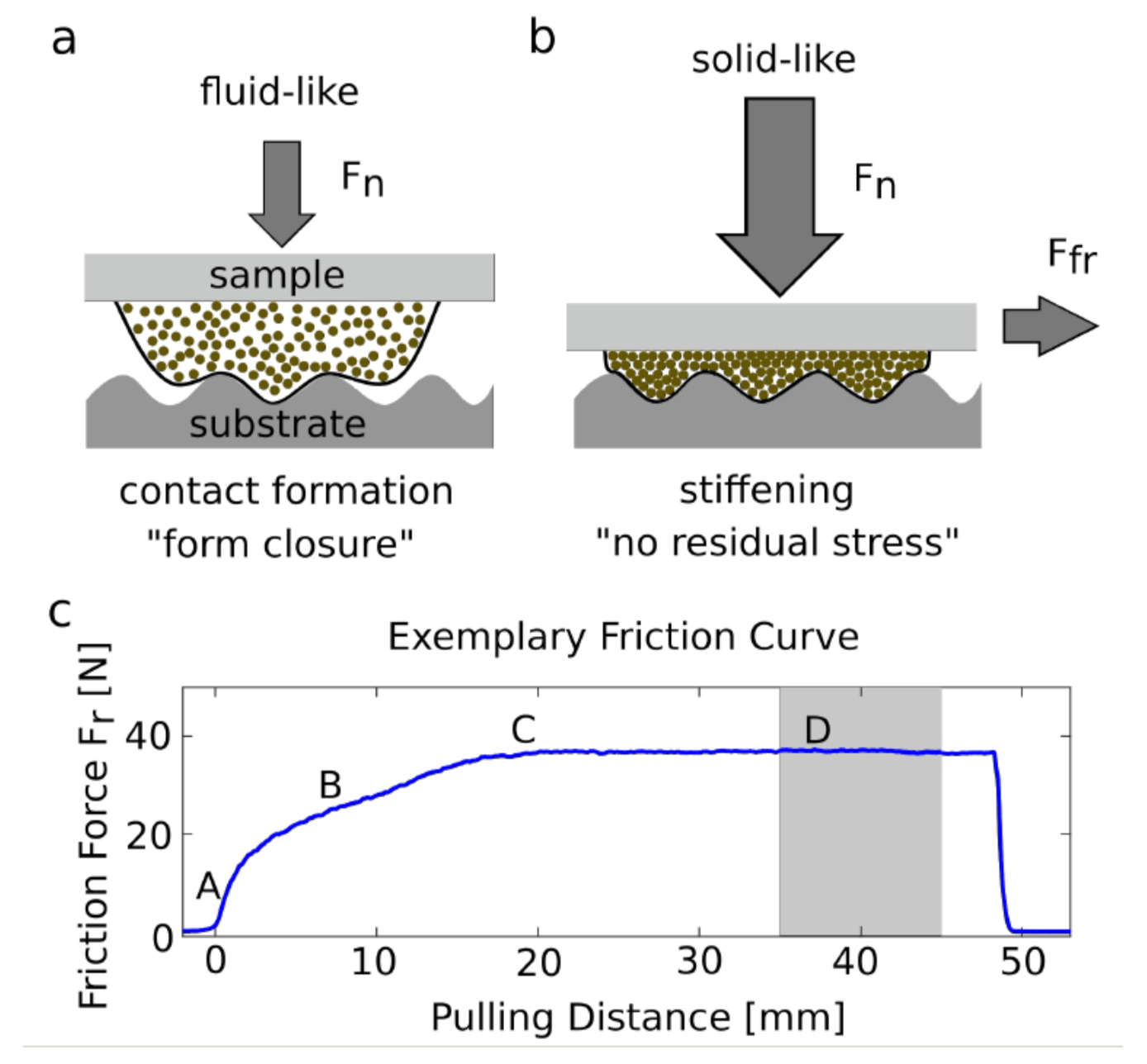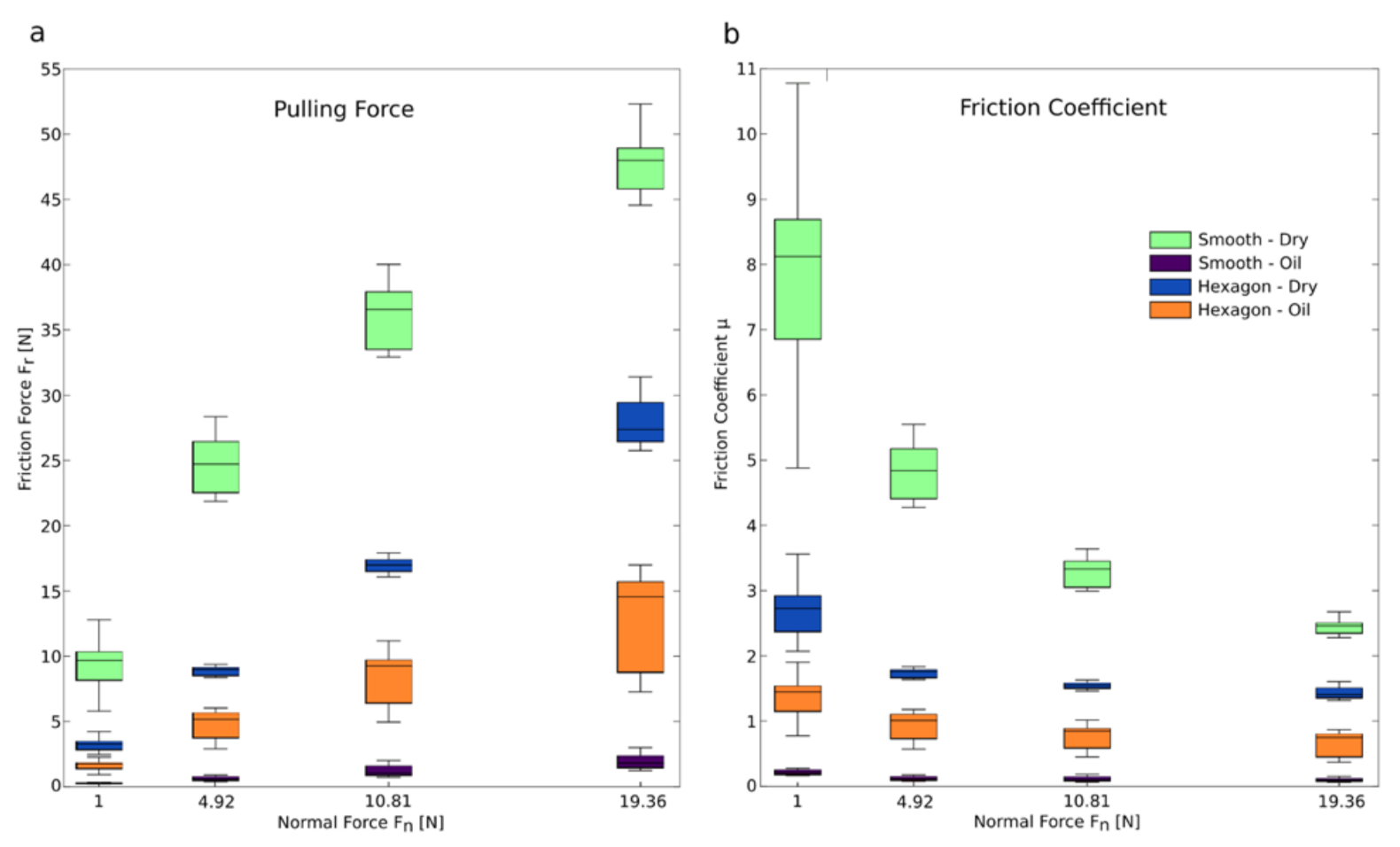Granular Media Friction Pad for Robot Shoes—Hexagon Patterning Enhances Friction on Wet Surfaces
Abstract
:1. Introduction
2. Materials and Methods
3. Results
3.1. Dry Substrate
3.2. Oiled Substrate
4. Discussion
Author Contributions
Funding
Data Availability Statement
Acknowledgments
Conflicts of Interest
References
- Tramsen, H.; Filippov, A.E.; Gorb, S.N.; Heepe, L. Maximizing Friction by Passive Jamming. Adv. Mater. Interfaces 2020, 7, 1901930. [Google Scholar] [CrossRef] [Green Version]
- Jaeger, H.M. Celebrating soft matter’s 10th anniversary: Toward jamming by design. Soft Matter 2015, 11, 12–27. [Google Scholar] [CrossRef]
- Majmudar, T.S.; Sperl, M.; Luding, S.; Behringer, R.P. Jamming transition in granular systems. Phys. Rev. Lett. 2007, 98, 058001. [Google Scholar] [CrossRef] [Green Version]
- Brown, E.; Rodenberg, N.; Amend, J.; Mozeika, A.; Steltz, E.; Zakin, M.R.; Lipson, H.; Jaeger, H.M. Universal robotic gripper based on the jamming of granular material. Proc. Natl. Acad. Sci. USA 2010, 107, 18809–18814. [Google Scholar] [CrossRef] [Green Version]
- Jaeger, H.M.; Nagel, S.R.; Behringer, R.P. Granular solids, liquids, and gases. Rev. Mod. Phys. 1996, 68, 1259–1273. [Google Scholar] [CrossRef]
- Miller, B.; O’Hern, C.; Behringer, R.P. Stress fluctuations for continuously sheared granular materials. Phys. Rev. Lett. 1996, 77, 3110. [Google Scholar] [CrossRef] [PubMed] [Green Version]
- Albert, I.; Sample, J.G.; Morss, A.J.; Rajagopalan, S.; Barabási, A.L.; Schiffer, P. Granular drag on a discrete object: Shape effects on jamming. Phys. Rev. E 2001, 64, 61303. [Google Scholar] [CrossRef] [PubMed] [Green Version]
- Forterre, Y.; Pouliquen, O. Flows of dense granular media. Annu. Rev. Fluid Mech. 2008, 40, 1–24. [Google Scholar] [CrossRef] [Green Version]
- Bi, D.; Zhang, J.; Chakraborty, B.; Behringer, R.P. Jamming by shear. Nature 2011, 480, 355–358. [Google Scholar] [CrossRef]
- Corwin, E.I.; Jaeger, H.M.; Nagel, S.R. Structural signature of jamming in granular media. Nature 2005, 435, 1075–1078. [Google Scholar] [CrossRef]
- Cates, M.E.; Wittmer, J.P.; Bouchaud, J.P.; Claudin, P. Jamming, force chains, and fragile matter. Phys. Rev. Lett. 1998, 81, 1841–1844. [Google Scholar] [CrossRef] [Green Version]
- Persson, B.N.J. Silicone rubber adhesion and sliding friction. Tribol. Lett. 2016, 62, 1–5. [Google Scholar] [CrossRef]
- Popov, V.L. Contact Mechanics and Friction; Springer: Berlin/Heidelberg, Germany, 2010. [Google Scholar]
- Persson, B.N.J. Theory of rubber friction and contact mechanics. J. Chem. Phys. 2001, 115, 3840–3861. [Google Scholar] [CrossRef] [Green Version]
- Amend, J.R.; Brown, E.; Rodenberg, N.; Jaeger, H.M.; Lipson, H. A positive pressure universal gripper based on the jamming of granular material. IEEE Trans. Robot. 2012, 28, 341–350. [Google Scholar] [CrossRef]
- Najmuddin, A.; Fukuoka, Y.; Ochiai, S. Experimental development of stiffness adjustable foot sole for use by bipedal robots walking on uneven terrain. In Proceedings of the 2012 IEEE/SICE International Symposium on System Integration, Fukuoka, Japan, 16–18 December 2012; pp. 248–253. [Google Scholar]
- Cheng, N.G.; Lobovsky, M.B.; Keating, S.J.; Setapen, A.M.; Gero, K.I.; Hosoi, A.E.; Iagnemma, K.D. Design and analysis of a robust, low-cost, highly articulated manipulator enabled by jamming of granular media. In Proceedings of the 2012 IEEE International Conference on Robotics and Automation, Guangzhou, China, 11–14 December 2012; pp. 4328–4333. [Google Scholar]
- Hauser, S.; Eckert, P.; Tuleu, A.; Ijspeert, A. Friction and damping of a compliant foot based on granular jamming for legged robots. In Proceedings of the 2016 6th IEEE International Conference on Biomedical Robotics and Biomechatronics, Singapore, 26–29 June 2016; pp. 1160–1165. [Google Scholar]
- Hauser, S.; Melo, K.; Mutlu, M.; Ijspeert, A. Fast state switching of a jamming-based foot. In Proceedings of the 8th International Symposium on Adaptive Motion of Animals and Machines (AMAM2017), Sapporo, Japan, 27–30 June 2017. [Google Scholar]
- Hauser, S.; Mutlu, M.; Banzet, P.; Ijspeert, A.J. Compliant universal grippers as adaptive feet in legged robots. Adv. Robot. 2018, 32, 825–836. [Google Scholar] [CrossRef]
- Tramsen, H.; Heepe, L.; Gorb, S.N. Granular Media Friction Pad—Soft vs. Stiff. Appl. Sci. 2021, in press. [Google Scholar]
- Drotlef, D.-M.; Stepien, L.; Kappl, M.; Barnes, W.J.P.; Butt, H.-J.; del Campo, A. Insights into the adhesive mechanisms of tree frogs using artificial mimics. Adv. Funct. Mater. 2013, 23, 1137–1146. [Google Scholar] [CrossRef]
- Persson, B.N.J.; Tartaglino, U.; Albohr, O.; Tosatti, E. Rubber friction on wet and dry road surfaces: The sealing effect. Phys. Rev. B 2005, 71, 35428. [Google Scholar] [CrossRef] [Green Version]
- Roberts, A.D. Squeeze films between rubber and glass. J. Phys. D Appl. Phys. 1971, 4, 423–432. [Google Scholar] [CrossRef]
- Federle, W.; Barnes, W.J.P.; Baumgartner, W.; Drechsler, P.; Smith, J.M. Wet but not slippery: Boundary friction in tree frog adhesive toe pads. J. R. Soc. Interface 2006, 3, 689–697. [Google Scholar] [CrossRef] [Green Version]
- Chen, H.; Zhang, L.; Zhang, D.; Zhang, P.; Han, Z. Bioinspired surface for surgical graspers based on the strong wet friction of tree frog toe pads. ACS Appl. Mater. Interfaces 2015, 7, 13987–13995. [Google Scholar] [CrossRef] [PubMed]
- Varenberg, M.; Gorb, S.N. Hexagonal surface micropattern for dry and wet friction. Adv. Mater. 2009, 21, 483–486. [Google Scholar] [CrossRef]
- Barnes, W.J.P.; Perez Goodwyn, P.J.; Nokhbatolfoghahai, M.; Gorb, S.N. Elastic modulus of tree frog adhesive toe pads. J. Comp. Physiol. A 2011, 197, 969–978. [Google Scholar] [CrossRef] [PubMed] [Green Version]
- Gorb, S.N.; Scherge, M. Biological microtribology: Anisotropy in frictional forces of orthopteran attachment pads reflects the ultrastructure of a highly deformable material. Proc. R. Soc. Lond. B 2000, 267, 1239–1244. [Google Scholar] [CrossRef] [PubMed]
- Büscher, T.H.; Buckley, T.R.; Grohmann, C.; Gorb, S.N.; Bradler, S. The evolution of tarsal adhesive microstructures in stick and leaf insects (Phasmatodea). Front. Ecol. Evol. 2018, 6, 69. [Google Scholar] [CrossRef] [Green Version]
- Green, D.M.; Alberch, P. Interdigital webbing and skin morphology in the neotropical salamander genus Bolitoglossa (Amphibia; Plethodontidae). J. Morphol. 1981, 170, 273–282. [Google Scholar] [CrossRef] [PubMed]
- Wei, H.; Wang, X. Biomimetic design of elastomer surface pattern for friction control under wet conditions. Bioinspiration Biomim. 2013, 8, 46001. [Google Scholar]
- Barnes, W.J.P. Functional morphology and design constraints of smooth adhesive pads. MRS Bull. 2007, 32, 479–485. [Google Scholar] [CrossRef]
- Kosaki, A.; Yamaoka, R. Chemical composition of footprints and cuticula lipids of three species of lady beetles. Jpn. J. Appl. Entomol. Zool. 1996, 40, 47–53. [Google Scholar] [CrossRef]
- Rand, C.J.; Crosby, A.J. Friction of soft elastomeric wrinkled surfaces. J. Appl. Phys. 2009, 106, 64913. [Google Scholar] [CrossRef] [Green Version]
- Barnes, W.J.P. Tree frogs and tire technology. Tire Technol. Int. 1999, 99, 42–47. [Google Scholar]
- Barnes, W.J.P.; Smith, J.; Oines, C.; Mundl, R. Bionics and wet grip. Tire Technol. Int. 2002, 2002, 56–60. [Google Scholar]
- Persson, B.N.J. Wet adhesion with application to tree frog adhesive toe pads and tires. J. Phys. Condens. Matter 2007, 19, 376110. [Google Scholar] [CrossRef]
- Gorb, S.N.; Jiao, Y.; Scherge, M. Ultrastructural architecture and mechanical properties of attachmentpads in Tettigonia viridissima (Orthoptera Tettigoniidae). J. Comp. Physiol. A 2000, 186, 821–831. [Google Scholar] [CrossRef]
- Federle, W.; Endlein, T. Locomotion and adhesion: Dynamic control of adhesive surface contact in ants. Arthropod Struct. Dev. 2004, 33, 67–75. [Google Scholar] [CrossRef] [PubMed]
- Hanna, G.; Barnes, W.J.P. Adhesion and detachment of the toe pads of tree frogs. J. Exp. Biol. 1991, 155, 103–125. [Google Scholar] [CrossRef]
- Federle, W.; Brainerd, E.L.; McMahon, T.A.; Hölldobler, B. Biomechanics of the movable pretarsal adhesive organ in ants and bees. Proc. Natl. Acad. Sci. USA 2001, 98, 6215–6220. [Google Scholar] [CrossRef] [Green Version]
- Jiao, Y.; Gorb, S.N.; Scherge, M. Adhesion measured on the attachment pads of Tettigonia viridissima (Orthoptera, Insecta). J. Exp. Biol. 2000, 203, 1887–1895. [Google Scholar] [CrossRef] [PubMed]
- Peressadko, A.G.; Hosoda, N.; Persson, B.N.J. Influence of surface roughness on adhesion between elastic bodies. Phys. Rev. Lett. 2005, 95, 124301. [Google Scholar] [CrossRef] [Green Version]
- Heise, R.; Popov, V.L. Adhesive contribution to the coefficient of friction between rough surfaces. Tribol. Lett. 2010, 39, 247–250. [Google Scholar] [CrossRef]
- Voigt, D.; Karguth, A.; Gorb, S.N. Shoe soles for the gripping robot: Searching for polymer-based materials maximising friction. Robot. Auton. Syst. 2012, 60, 1046–1055. [Google Scholar] [CrossRef]
- Varenberg, M.; Gorb, S.N. Shearing of fibrillar adhesive microstructure: Friction and shear-related changes in pull-off force. J. R. Soc. Interface 2007, 4, 721–725. [Google Scholar] [CrossRef] [PubMed] [Green Version]
- Varenberg, M.; Gorb, S.N. Close-up of mushroom-shaped fibrillar adhesive microstructure: Contact element behaviour. J. R. Soc. Interface 2007, 5, 785–789. [Google Scholar] [CrossRef] [Green Version]
- Murarash, B.; Itovich, Y.; Varenberg, M. Tuning elastomer friction by hexagonal surface patterning. Soft Matter 2011, 7, 5553–5557. [Google Scholar] [CrossRef]



| Fn [N] | Smooth | Hexagon | ||
|---|---|---|---|---|
| Dry | Oil | Dry | Oil | |
| 1.00 | 7.9 ± 1.5 | 0.2 ± 0.1 | 2.7 ± 0.4 | 1.4 ± 0.3 |
| 4.92 | 4.8 ± 0.4 | 0.1 ± 0.1 | 1.7 ± 0.1 | 0.9 ± 0.2 |
| 10.81 | 3.3 ± 0.2 | 0.1 ± 0.1 | 1.5 ± 0.1 | 0.8 ± 0.2 |
| 19.36 | 2.5 ± 0.1 | 0.1 ± 0.1 | 1.4 ± 0.1 | 0.7 ± 0.2 |
Publisher’s Note: MDPI stays neutral with regard to jurisdictional claims in published maps and institutional affiliations. |
© 2021 by the authors. Licensee MDPI, Basel, Switzerland. This article is an open access article distributed under the terms and conditions of the Creative Commons Attribution (CC BY) license (https://creativecommons.org/licenses/by/4.0/).
Share and Cite
Tramsen, H.T.; Heepe, L.; Gorb, S.N. Granular Media Friction Pad for Robot Shoes—Hexagon Patterning Enhances Friction on Wet Surfaces. Appl. Sci. 2021, 11, 11287. https://doi.org/10.3390/app112311287
Tramsen HT, Heepe L, Gorb SN. Granular Media Friction Pad for Robot Shoes—Hexagon Patterning Enhances Friction on Wet Surfaces. Applied Sciences. 2021; 11(23):11287. https://doi.org/10.3390/app112311287
Chicago/Turabian StyleTramsen, Halvor T., Lars Heepe, and Stanislav N. Gorb. 2021. "Granular Media Friction Pad for Robot Shoes—Hexagon Patterning Enhances Friction on Wet Surfaces" Applied Sciences 11, no. 23: 11287. https://doi.org/10.3390/app112311287
APA StyleTramsen, H. T., Heepe, L., & Gorb, S. N. (2021). Granular Media Friction Pad for Robot Shoes—Hexagon Patterning Enhances Friction on Wet Surfaces. Applied Sciences, 11(23), 11287. https://doi.org/10.3390/app112311287







